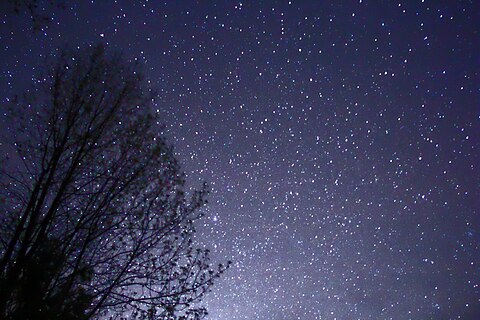We live in the lowest part of the atmosphere, even those of us living at high altitude. Within that lower portion there are many layers that swirl and churn invisibly over our heads. That activity becomes visible when we look at light that passes through it, especially light that comes from a "point source", that is, a star.
Each of these layers has a different temperature. The temperature differences affect how they interact at the boundaries between layers. If you've ever seen a layered fluid, with each layer a different color, as you might get in a layered drink, this is similar to the layers in the atmosphere.

Image courtesy of Morpheus1703
Refraction is the word for that disturbance. It's the same effect that we use in lenses to focus light. The ordinary type of telescope that people think of, that has a large lens facing the sky and a small lens near your eye is called a refractor telescope because it uses refraction to create its image. Its lenses are made of glass that doesn't change shape much, which refracts light by only so much--no more no less. The atmosphere, however, is like a lot of liquid lenses all flowing over and around each other, constantly changing shape and position.
Seeing is the word used in astronomy to describe how good or how bad the atmosphere is affecting the view of the sky outside the atmosphere. When we say the seeing is good, we're saying that the air is relatively still, the images are steady. When we say the seeing is bad, we're saying the turgid atmosphere is making it hard to see a clear image of the astronomical objects we're looking at.
Seeing can be different at different times of the night, of course. Once the ground has cooled hours after sunset after a sunny day, the seeing can improve dramatically. Or if the weather becomes still. The hours after midnight are the best for seeing in most places. But we can't all choose to engage in our hobby at that time if we have responsibilities in the morning.

Image courtesy of Philipp Salzgeber
Everything is infinitely far away so far as our eyes are concerned, when we're doing astronomy. The difference between the Moon, at a mere quarter million miles or about four hundred thousand kilometers, and the Andromeda Galaxy, which is eighty trillion times further away than the Moon, is indistinguishable to our eyes. Everything might as well be equally far away. Our eyes can't distinguish details using the means that we normally use distance to give us cues when we're looking at things on Earth.
There is no apparent color for most things in space, with a few exceptions. At that, any color that does exist is pale and washed out by daytime standards. If we see color, it is usually more a matter of contrast between colors of objects that are near each other with significant differences.
We need to learn a new set of cues for actively seeing with our eyes for astronomy. It's not difficult, it just takes a little awareness and practice. Knowing what's happening is part of the solution. Aside from color and distance, we have to look hard to see many of the differences in lighting in astro objects, textures are subtle. Instead, we have to learn to use our eyes to "capture" images during moments of good seeing among the bad.
Relaxing the eye is key to capturing those moments of clarity. If we're straining to see, we're focusing entirely on the image we see now, trying to pick out detail. Instead, we need to relax and take our time, hanging over the eyepiece for a while, waiting for that moment of clarity to come.
The changing of the atmosphere can enhance as well as degrade the image we see, either with our eyes, or through the telescope. If we're waiting for that moment, relaxed, when it comes our eyes will "capture" those moments of superlative clarity. Sure, it's really happening in the brain, where all the image interpretation and processing is happening.
This is why the mount of the telescope becomes so important. It needs to be there for our eye, silently doing its job, keeping the telescope on the object we're viewing. We can't be stressing about the fact that the thing we're looking at is sliding out of view. We can't be using our built-in image processors to compensate for a wobbly, weak, or shaking mount--we want to save that capacity for dealing with the thing we can't do anything about, the cylinder of atmosphere that lies between the end of the telescope and the edge of outer space.
So, remember:
- You can get your eyes used to seeing with as much skill as night as during the day, but it'll be unfamiliar at first, and will take a little practice.
- You need to relax, and take your time at the eyepiece (even if there's a line of people waiting to look behind you. Take your moment and make it count. I guarantee, you're not going to be there as long as you fear you have been.
- The support for the instrument needs to be stable, reliable, and out of your mind when you're at the eyepiece.
- The atmosphere is going to do what it's going to do. Even if it is wild, and the image is bouncing around in the scope, there will still be occasional moments when the object you're viewing snaps into clarity. The difference between good seeing and bad is how long you have to wait for that to happen, and how long those moments of clarity last.

Your eyes can't tell that the stars are a few hundred million times as far away, except for Saturn to the lower left of the Moon, which is only 3,500 times as far away as the Moon.
Image courtesy of Ragesoss
A few objects show enough to even the unskilled eye to be magnificent. The Moon, Saturn, Jupiter. Other objects require a little more from us to meet them halfway. The Orion Nebula, Hercules Cluster, Andromeda Galaxy are relatively bright objects with details strong enough to enjoy easily, and there are several dozen more like them. Those object prepare us, and our eyes, for the next level. When we want more.
The good news is, that as your viewing skills increase, each dimmer, more subtle level of objects that you learn to appreciate has even more objects. From a handful of objects to a couple of dozen, we go to a few hundred. Once we have trained our eyes to appreciate those, objects such as the Black Eye Galaxy, M65 and M66, and the Little Dumbbell, we reach a point where there are not merely hundreds, but thousands of objects waiting for us to see them and appreciate their beauty. A lifetime pursuit opens up.
Many amateur astronomers specialize in a particular type of sight they seek, over the course of a season or for a few years. I myself spent a couple of years collecting new galaxies that I had seen. I shifted from that to globular clusters. First, in our own galaxy, then to those visible in other galaxies. Double stars and nebulas of particular types have also been among my "current interests" at different times of my life and under different sky conditions. The eruption of Mount Pinatubo in 1991, and the dust it put into the upper atmosphere, brought my galaxy-seeking to an end at that time, and for a few years afterward. That was when I shifted to globular clusters, which "shine through" the dust better than the faint details of a galaxy's halo.
That was also one of the times it struck me how lucky we are to have the sky that we have. Frustrating as it can be at times, our atmosphere is a wonderful thing, and our first gateway to the universe.




No comments:
Post a Comment